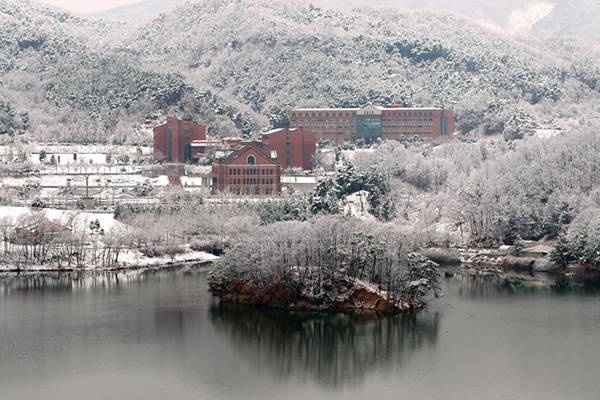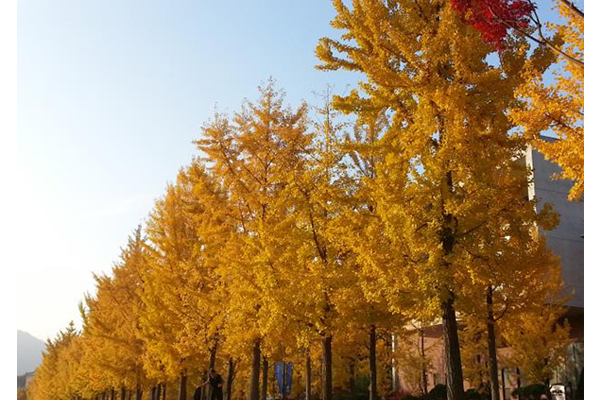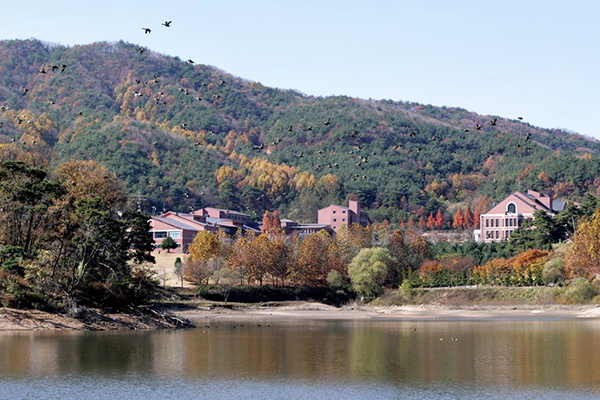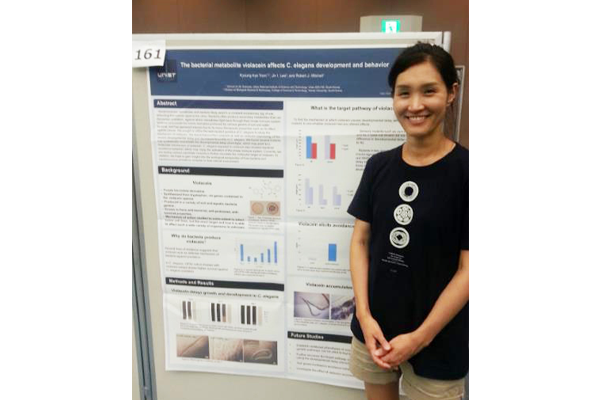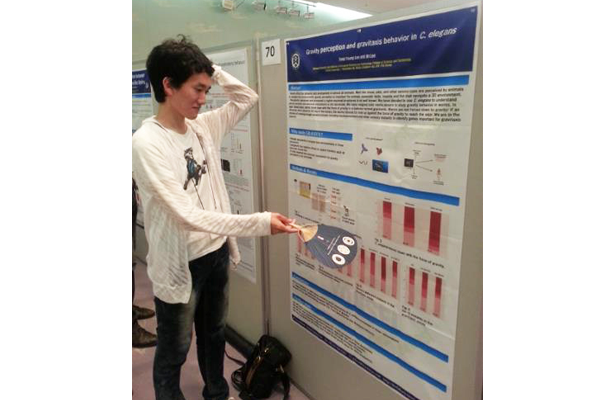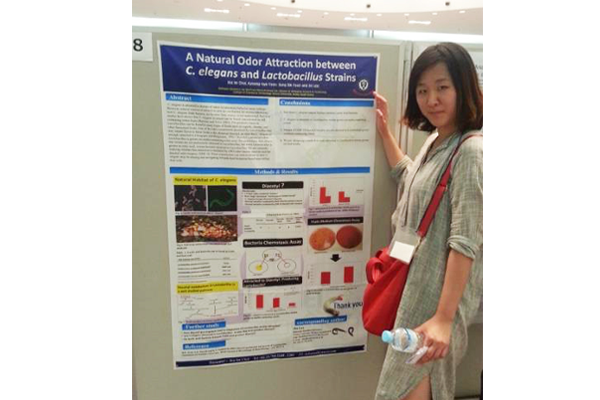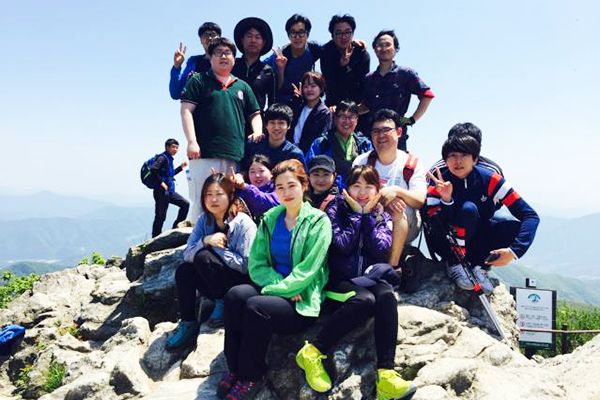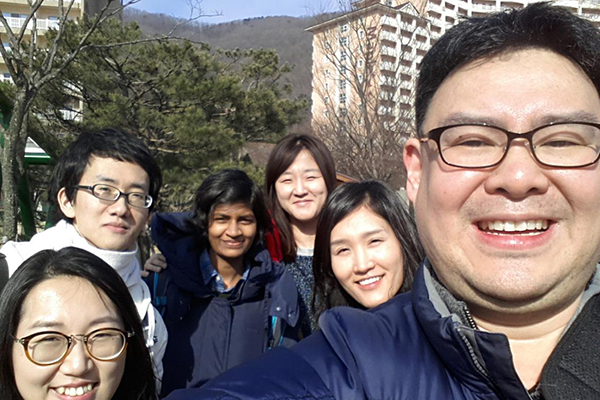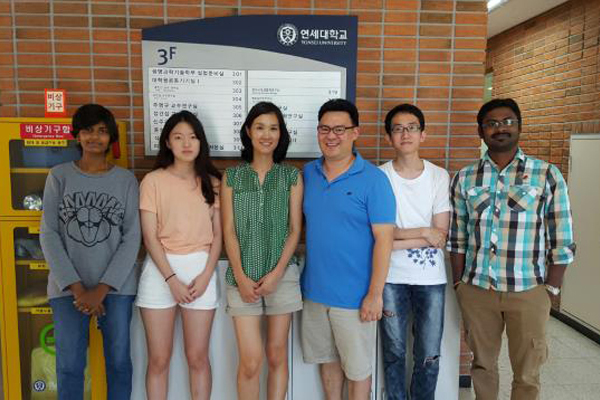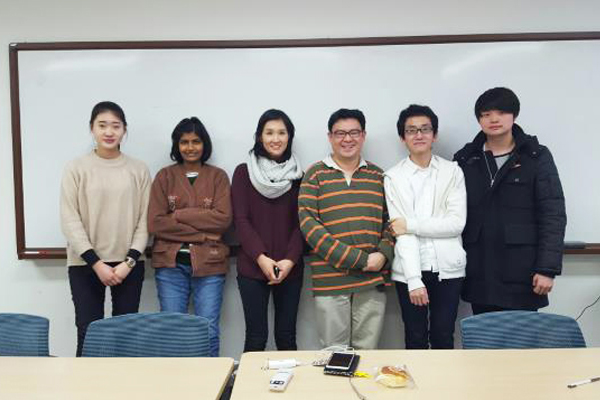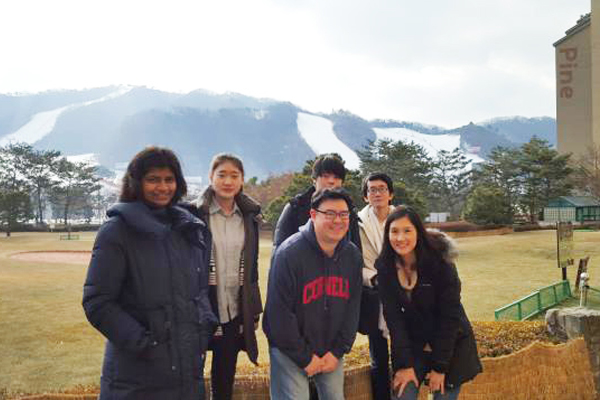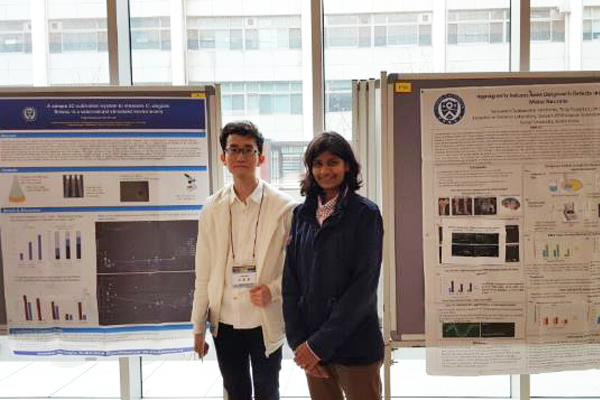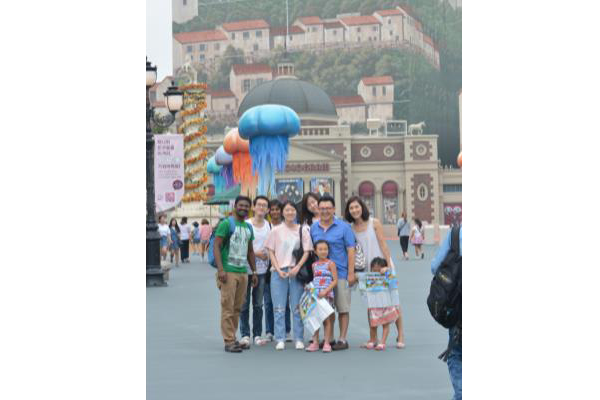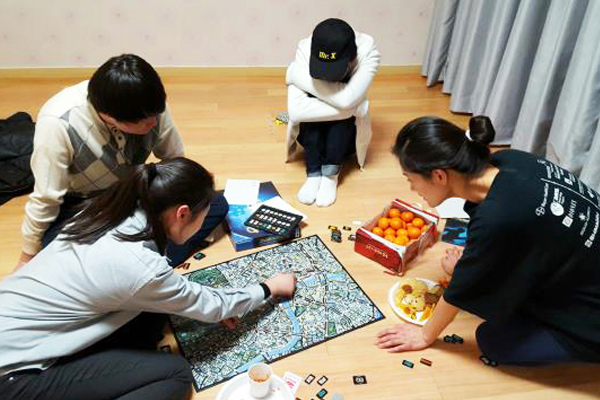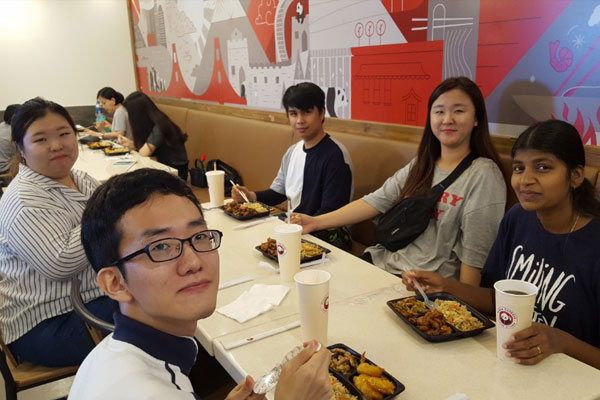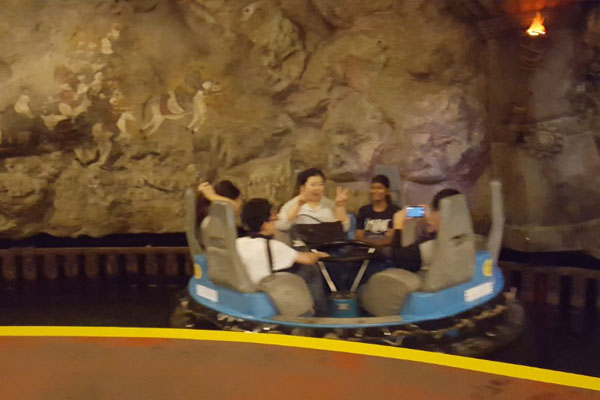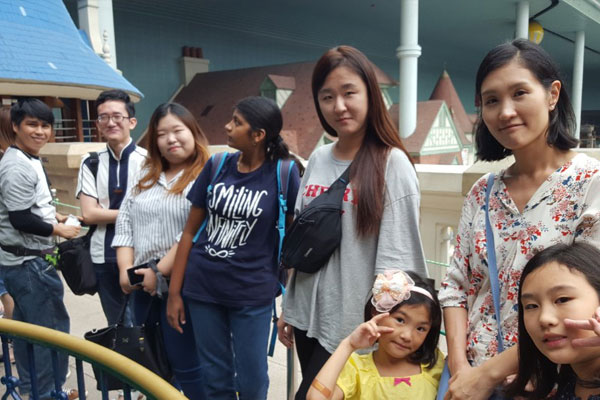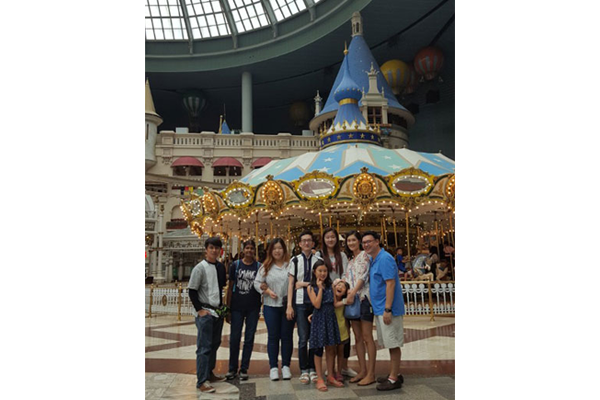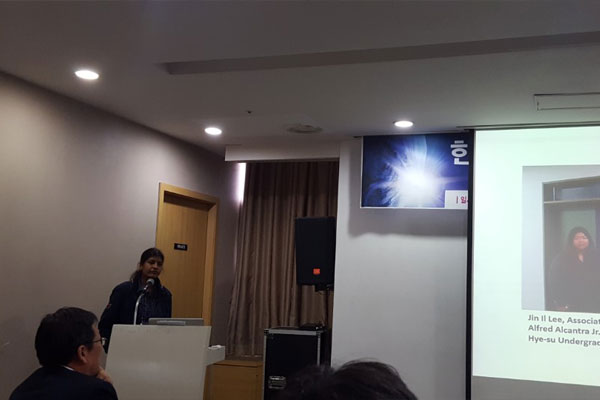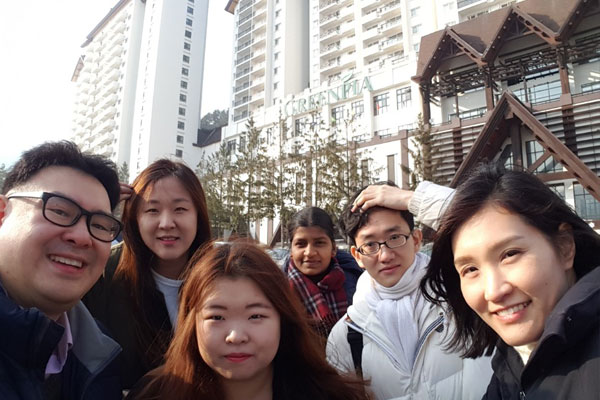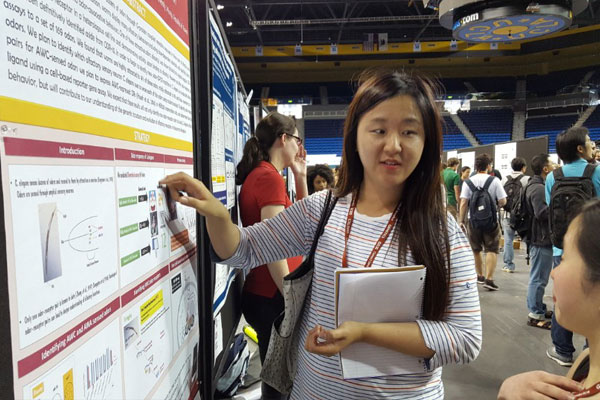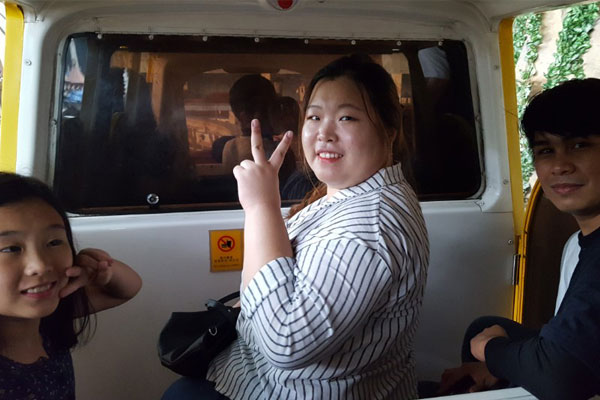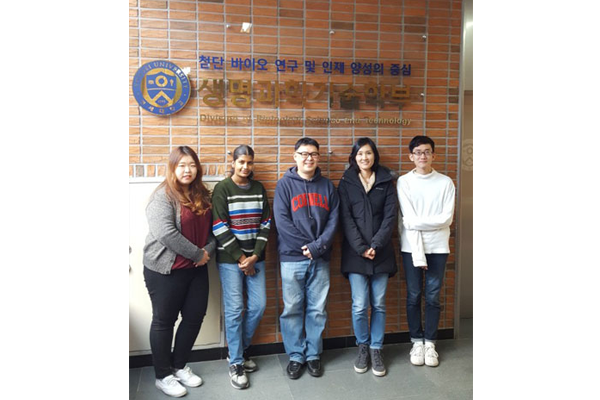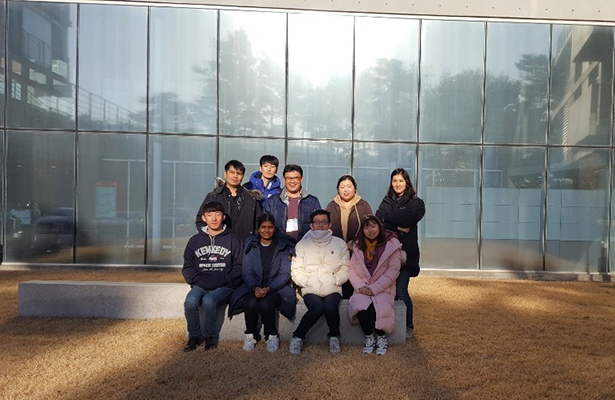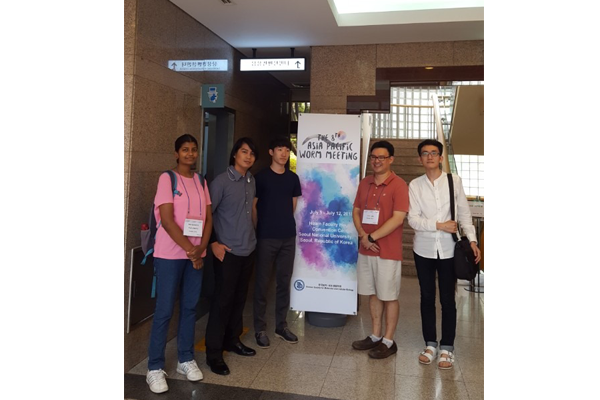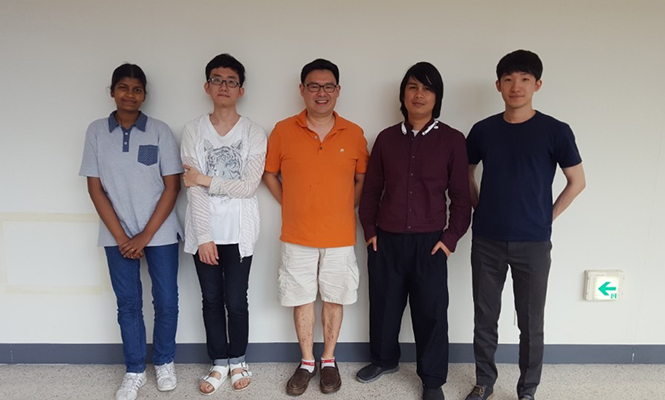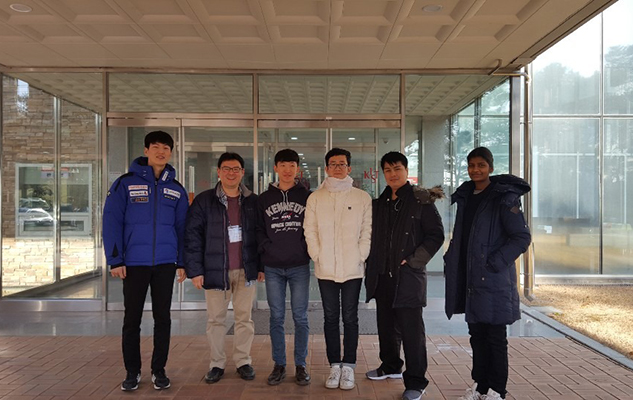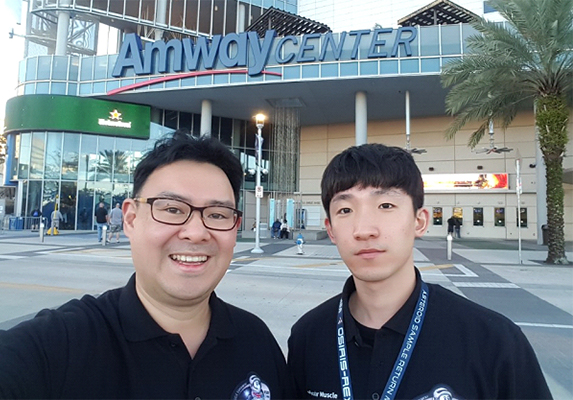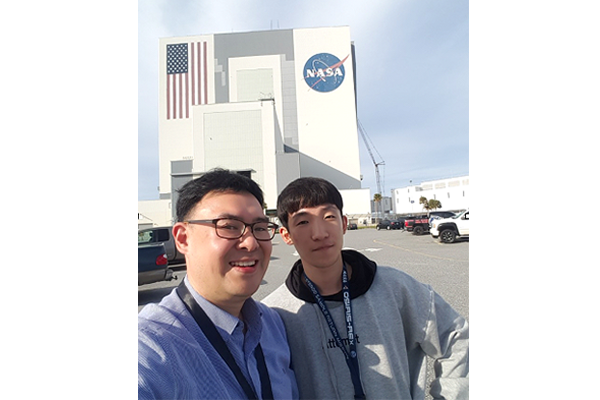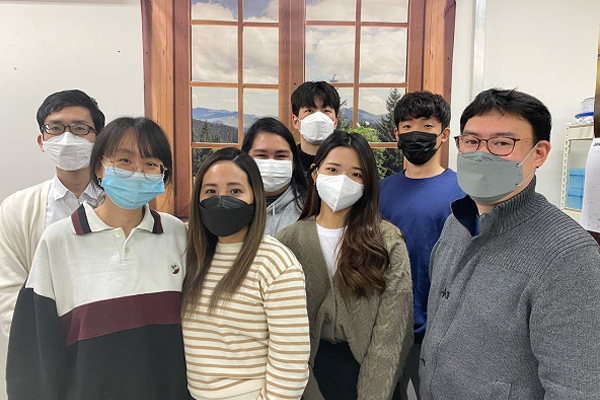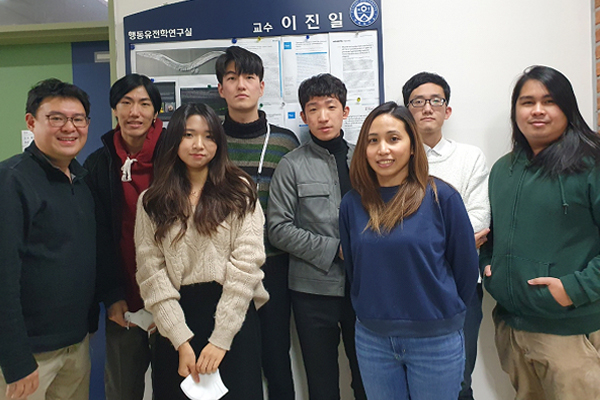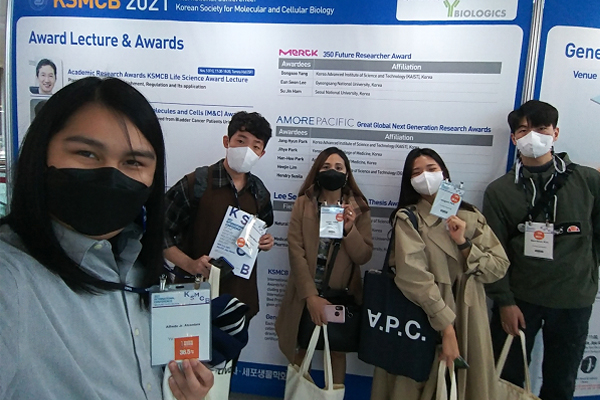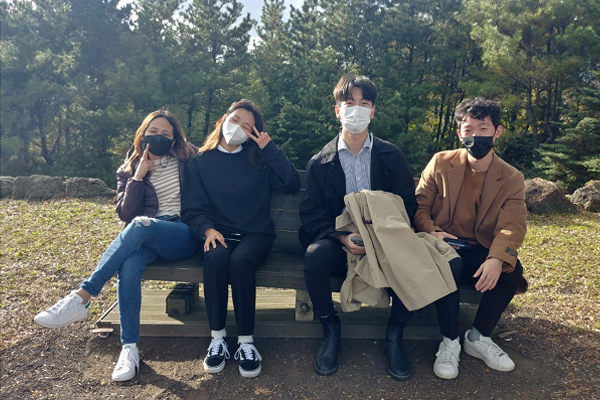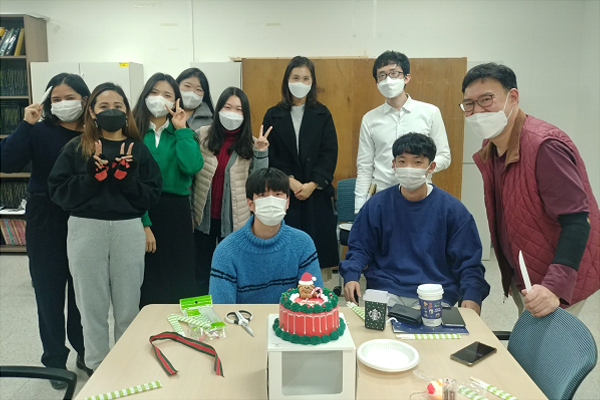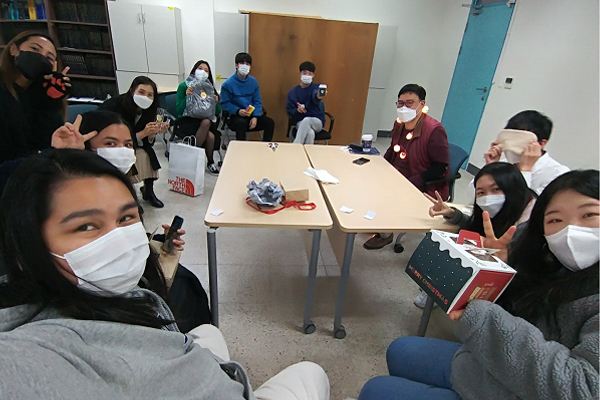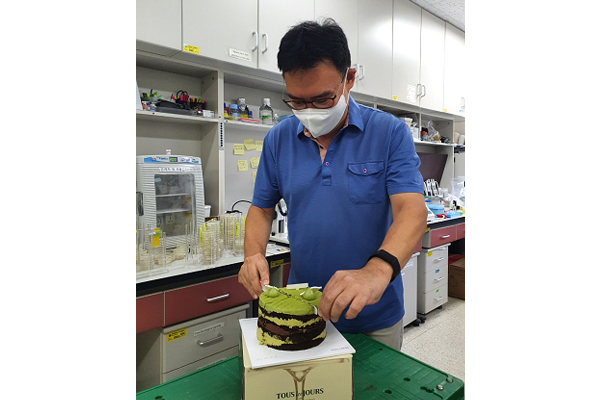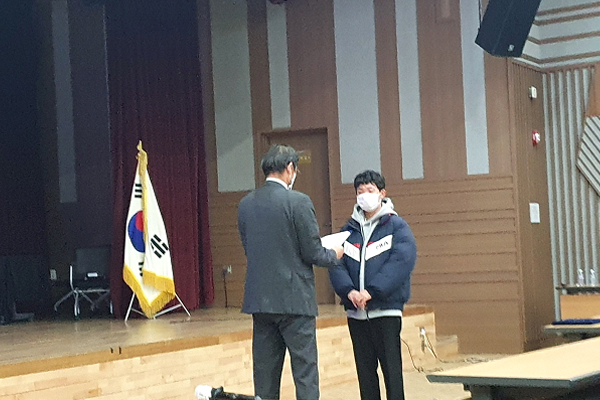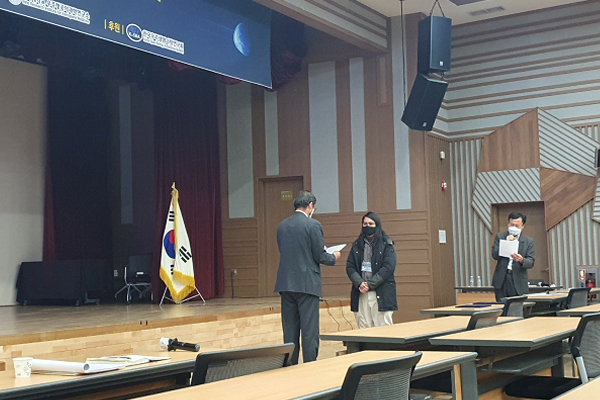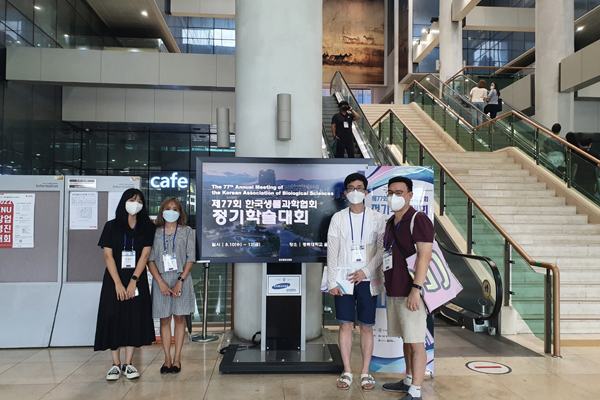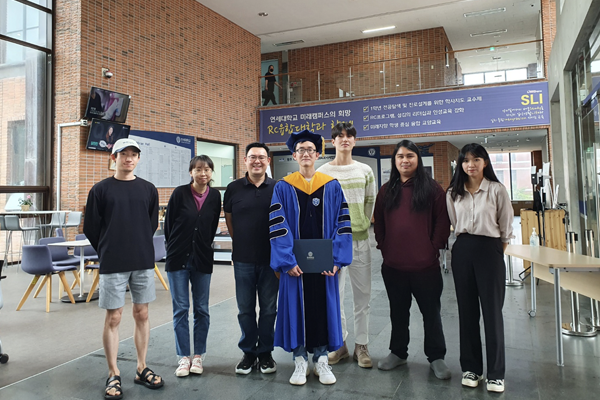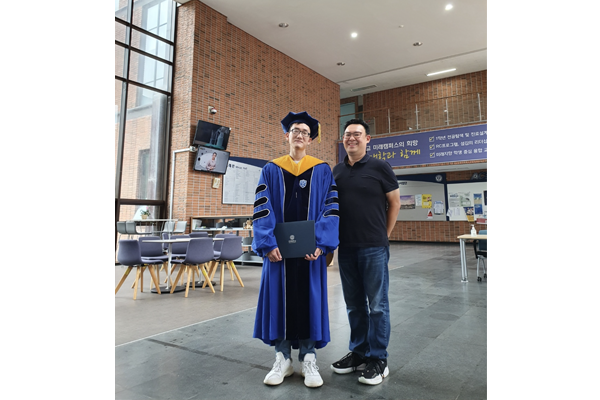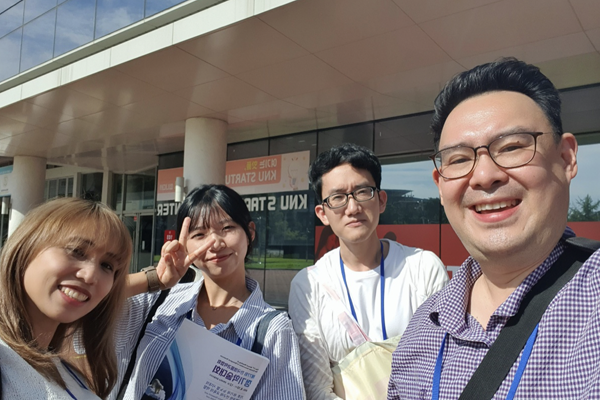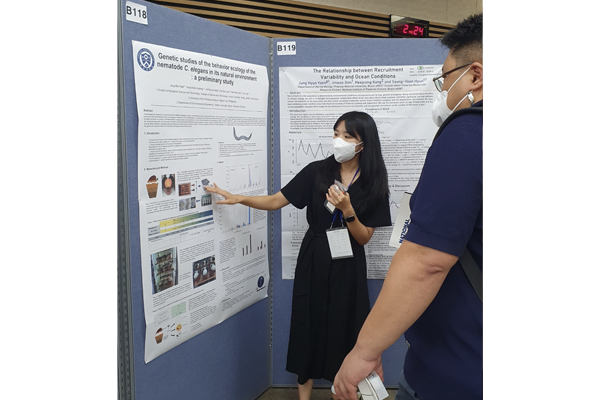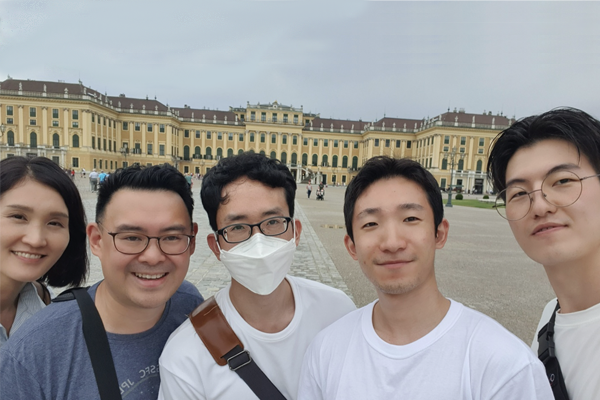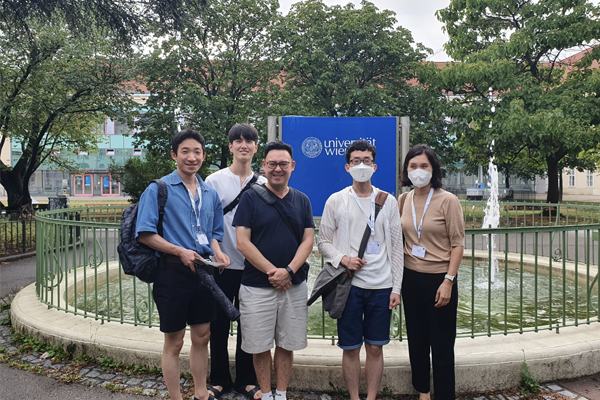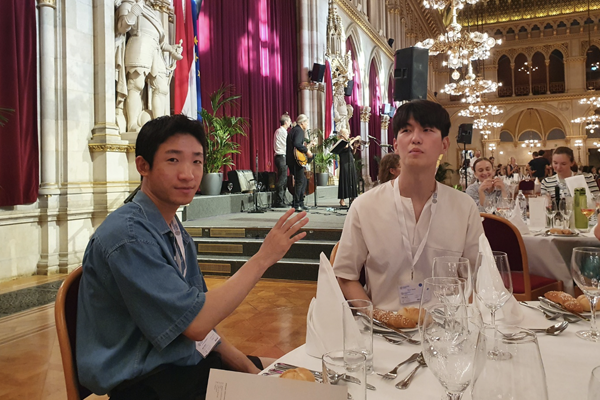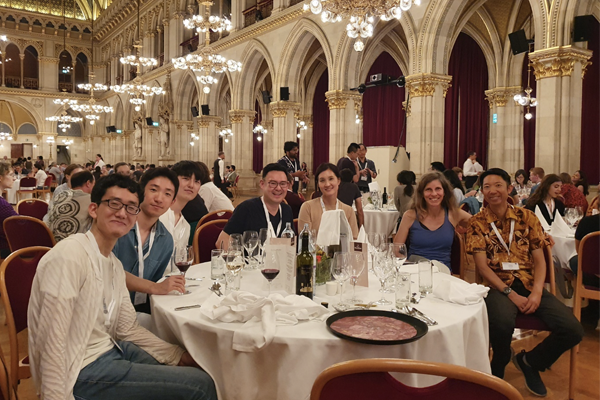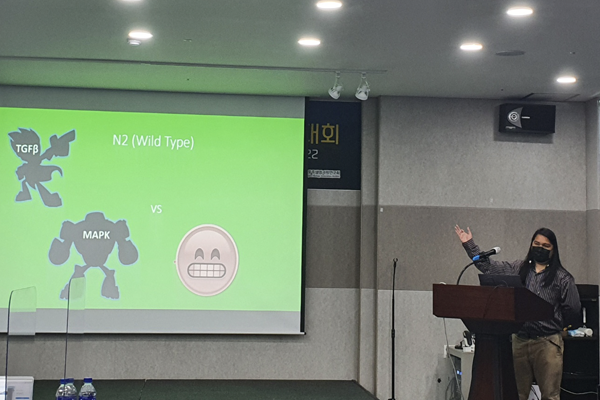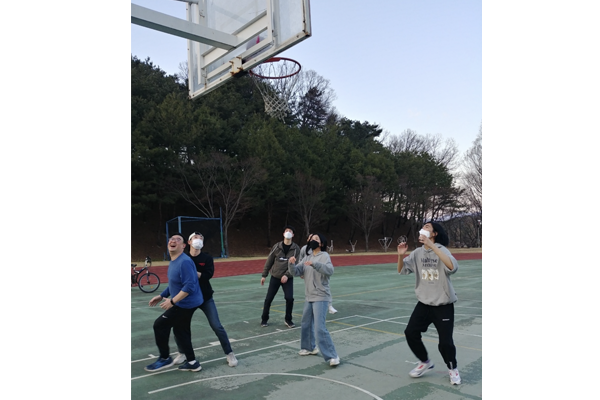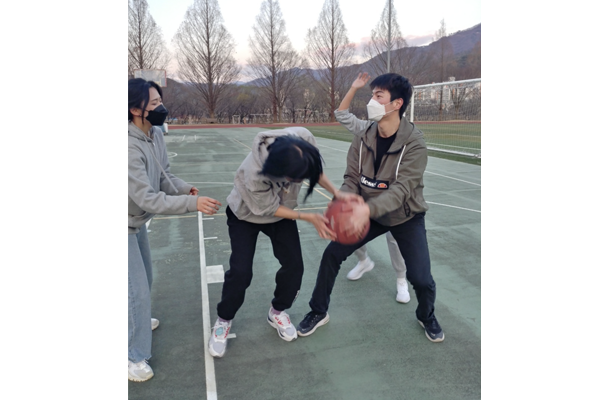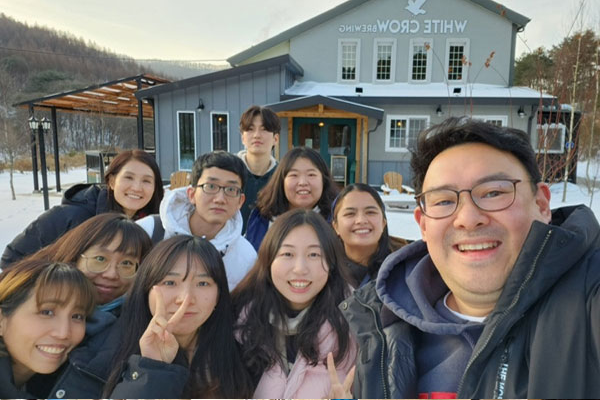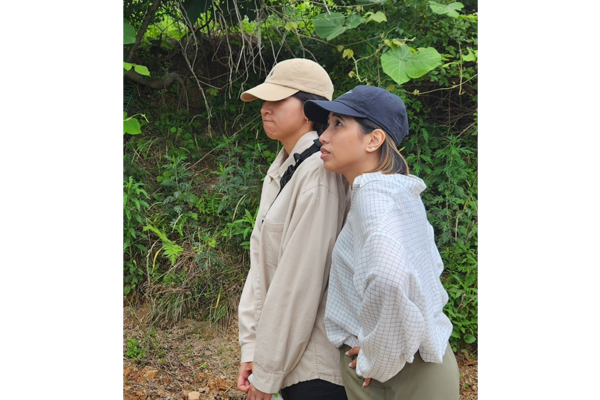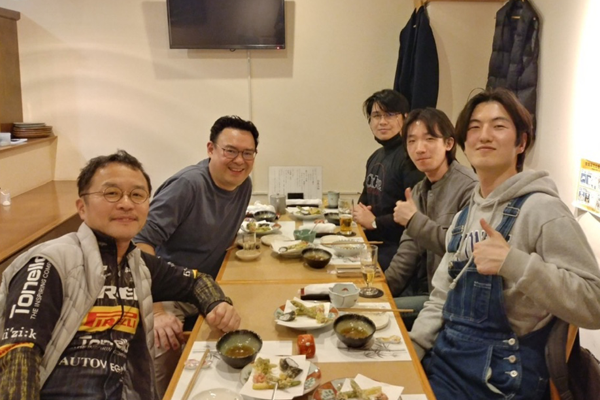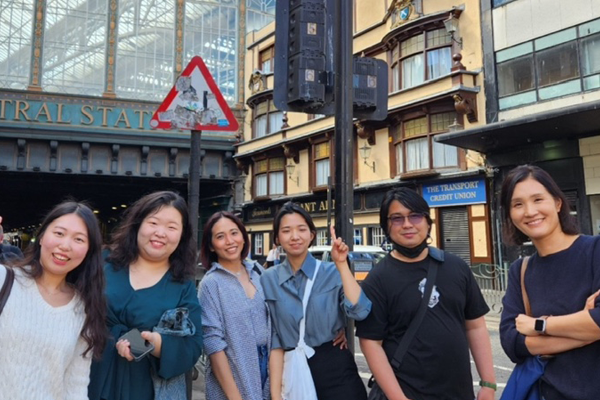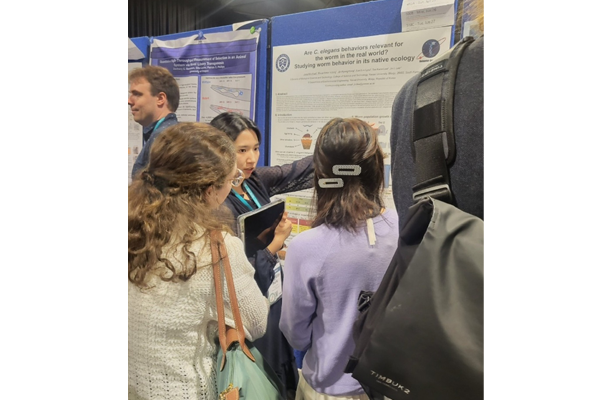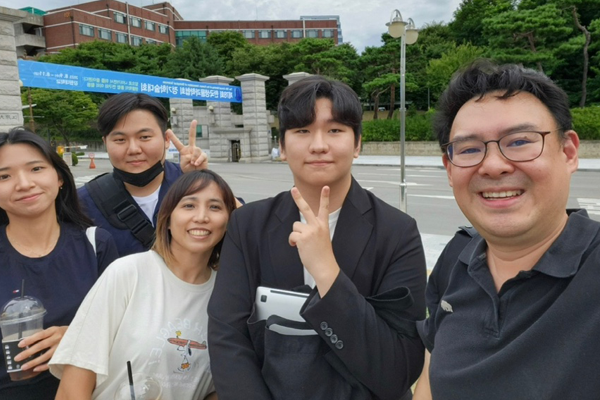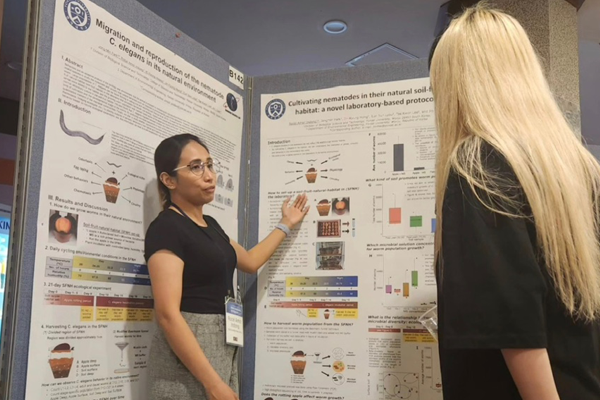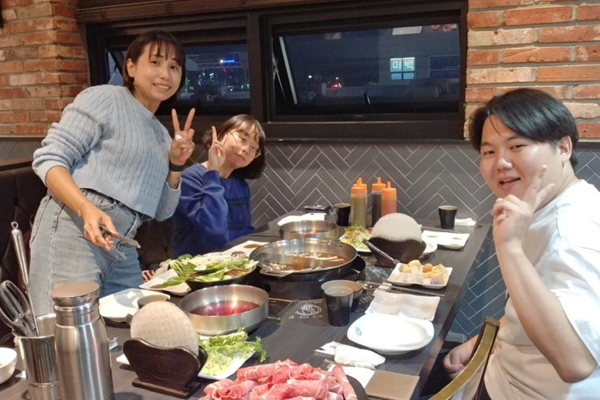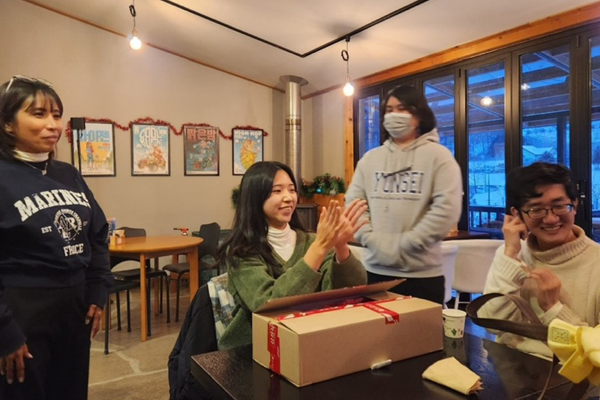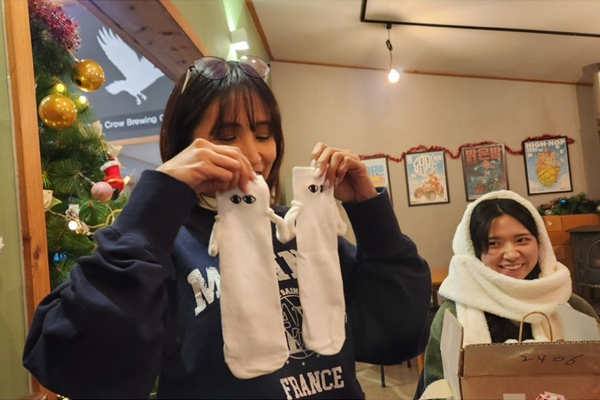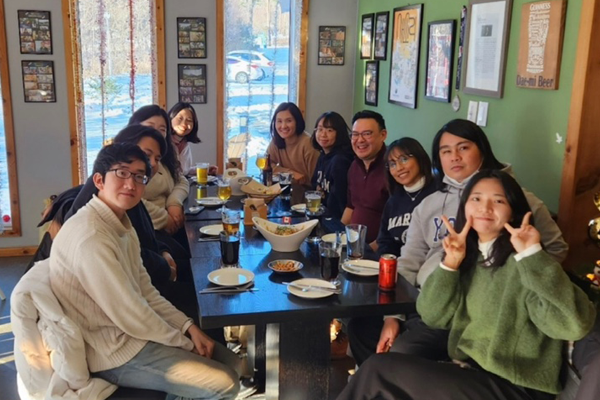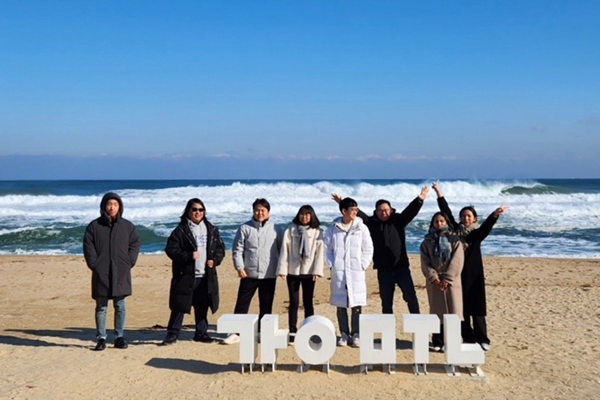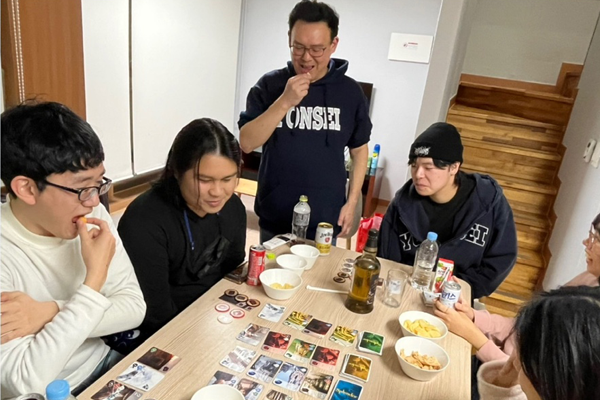BEHAVIORAL GENETICS LABORATORY
C. elegans has also been one of the most studied organisms in the world because of its use as a genetic model organism. In our lab we take advantage of these mutants and tools developed over decades and try to understand the complex ecological interaction between C. elegans and its environment, particularly its relationship with bacteria.

OUR LAB USES
the genetic model organism C. elegans to study several questions:
Ecology - How do nematodes interact with their natural environments?
Behavior - How do worms behave to increase their survival and reproductive success in their environments? What are the genes and circuitry that control these behaviors?
Space - How does gravity affect development and behavior of an animal?
Learn basics about C. elegans here or at Wiki.
Learn more about our research here!!
RESEARCH
- C. ELEGANS ECOLOGY
- With the onset of the genomic era, a new opportunity to study ecology at the genetic level is just dawning. In the Lee lab we use C. elegans genetics to study how the worm interacts with its environment and other organisms at the gene level. Our ultimate goal is to understand how nematodes use their genes to gain fitness advantages in nature. We are studying C. elegans ecology at several levels:
-
- C. elegans natural environments
In nature C. elegans can be found in places where their favorite food, bacteria, is found in abundance. You’ll especially find them on the ground in rotting fruit and vegetation. We found Caenorhabditis nematodes here in Korea in rotting peaches, pear and yuzu fruit (Choi et al, 2016). However, we would like to learn more about C elegans natural ecology and life history. What are the conditions that allow Caenorhabditis nematodes to grow and reproduce? Can we replicate those conditions in the laboratory? We have developed a protocol to cultivate C. elegans in soil and rotting fruit in the laboratory (Indong et al, 2024).

-
- Studying C. elegans in 3-D.
In the lab C. elegans is cultivated on an agar plate with E. coli bacteria, but in nature they live in soil and rotten fruits with diverse bacteria. Thus, the worms’ natural habitat is 3D rather than a flat 2D world as in the lab. We developed a system in our lab to cultivate worms in 3D called NGT-3D to study C. elegans development and behavior in three dimensions (Lee et al, 2016). By using behavioral analysis and video technology we are assessing worm behavior in 3D, and trying to relate these behaviors to reproductive fitness and evolution of the nematodes.
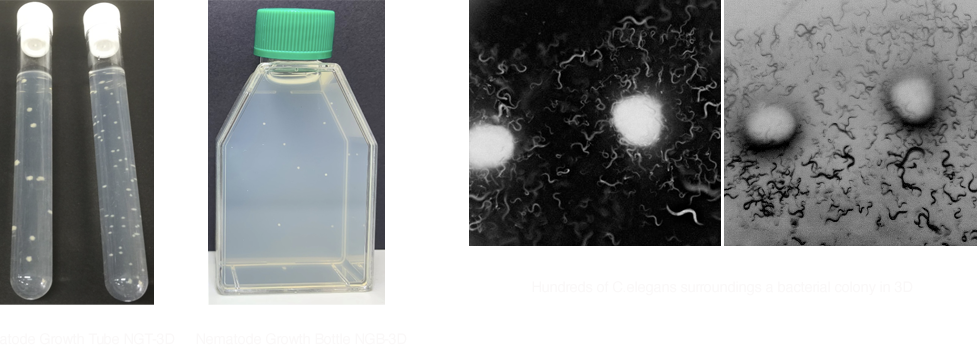
-
- C. elegans maternal and oviposition behavior
Maternal behaviors are important innate behaviors performed by mothers that increase the survival of its young. C. elegans mothers don’t actively care for their young, but they can control their egg laying. In adverse environments such as in the toxic bacterial metabolite violacein, mothers make the ultimate sacrifice by holding their eggs in their bodies resulting in internal hatching that leads to their own death but survival of the young, termed matriphagy (Yoon et al, 2020).
In the normal laboratory 2D plate culture of C. elegans, hermaphrodite mother worms lay eggs with no pattern. But in a 3D culture of C. elegans, we find that mothers will spread out the bacteria to form a “nest” of bacteria, and the mother worms actively moves away from the bacteria to lay its eggs, which we term 3D oviposition behavior. We identified low oxygen as a cue that induces oviposition behavior, and a neuropeptide and a receptor that regulate the behavior, and find that this behavior gives a fitness advantage for the survival of the young (Lee et al, 2022).
- C. ELEGANS IN SPACE
- Our future may be beyond this planet. However, before we travel throughout the galaxy and colonize other planets, we must understand how environments outside our Earth’s atmosphere are affecting our biology. How do changes in gravity affect our bodies and development? We are currently performing experiments to understand how high or low gravity can affect C. elegans muscle, neuronal development, and innate immunity using molecular biology and microscopy, and we have shown that space microgravity causes muscle atrophy in C. elegans, just as it does in humans (Kim et al, 2023). We are also beginning to assess how low gravity can affect neuron development using an instrument called a clinostat. Our lab has both a 2D clinostat and a 3D clinostat to simulate microgravity conditions. Finally, with an international team of scientists from Europe, USA and East Asia, we have sent C. elegans into space aboard the International Space Station in 2018, 2021 and 2022 to study the effect of space on neuron development, innate immunity and muscle atrophy. For more info on our spaceflight experiments in collaboration with the European Space Agency (ESA), check out the following link: www.mme-spaceworms.com
Here’s a Korean news article of our experiment: https://www.yna.co.kr/view/AKR20190411131200017

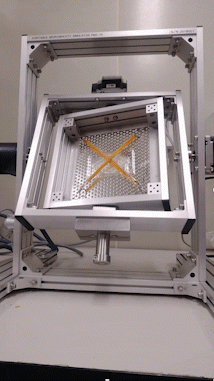

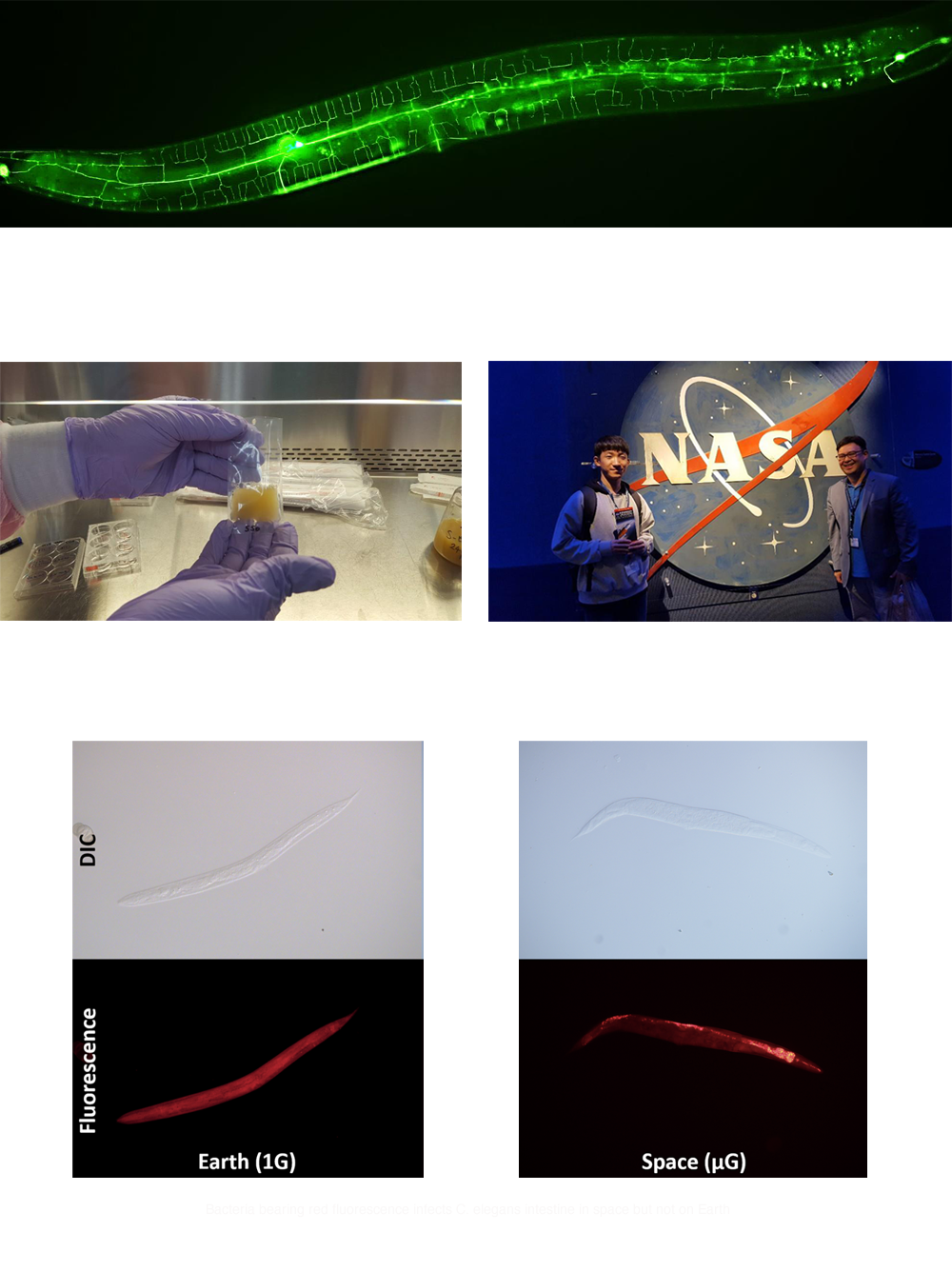
- C. ELEGANS ODOR BEHAVIOR
- Worms may seem like simple organisms, but they can sense and remember many things such as cultivation temperature, toxic foods, and smells. In conjunction with Dr. Kyoung-hye Yoon’s lab at Yonsei University Wonju Medical College, we study what odors worms can smell, what factors like age can alter their sense of smell, and are identifying the odor receptors that are responsible for sensing the odors.
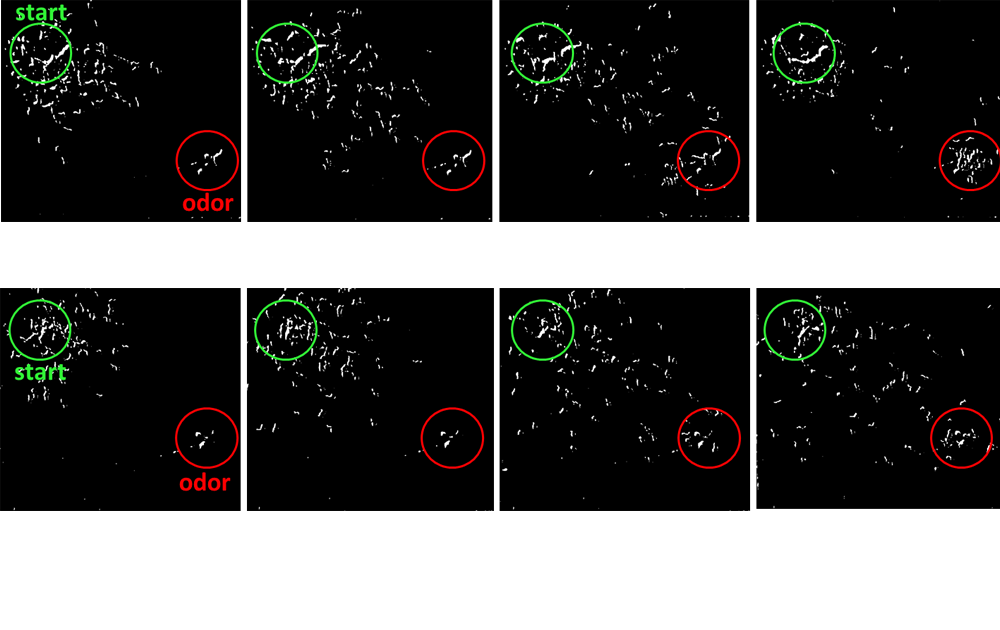
PUBLICATION
| TITLE & DESCRIPTION | WHO | LINK |
|---|---|---|
| A simple protocol for cultivating the bacterivorous soil nematode Caenorhabditis elegans in its natural ecology in the laboratory
Front. Microbiol., 2024 15:1347797. |
Indong RA, Park JM, Hong J, Lyou ES, Han T, Hong JK, Lee TK, Lee JI | https://doi.org/10.3389/fmicb.2024.1347797
|
| Comparative Analysis of Muscle Atrophy During Spaceflight, Nutritional Deficiency and Disuse in the Nematode Caenorhabditis elegans Int J Mol Sci, 2023 (24) 12640. |
Kim B, Alcantara AV, Moon J-H, Higashitani A, Higashitani N, Etheridge T, Szewczyk NJ, Deane CS, Gaffney CJ, Higashibata A, Hashizume T, Yoon K, Lee JI | https://doi.org/10.3390/ijms241612640
|
| Precise sensorimotor control impacts reproductive fitness of C. elegans in 3D environments
Neuroreport, 2023 35(2),123-128. |
Lee HK, Lee TY, Lee JI, Park K, Yoon K | https://doi.org/10.1097/WNR.0000000000001986
|
| A Smartphone-Based Imaging Method for C. elegans Lawn Avoidance Assay
J. Vis.Exp., 2023 (102), e65197 |
Kwon S, Lee JI, Yoon K | https://doi.org/10.3791/65197 |
| Green Tea Consumption and the COVID-19 Omicron Pandemic Era: Pharmacology and Epidemiology
Life, 2023 13(3) |
Storozhuk M, Lee S, Lee JI, Park J | https://doi.org/10.3390/life13030852 |
| The neuropeptide FLP-17 regulates an oviposition behavior in the nematode Caenorhabditis elegans that increases maternal reproductive fitness in low oxygen environments BioRxiv. 2022 |
Lee TY, Chang E, Yoon K-h, Lee JI | https://doi.org/10.1101/2022.11.15.516679 |
| Making “Sense” of Ecology from a Genetic Perspective: Caenorhabditis elegans, Microbes and Behavior Metabolites, 2022, 12(11), 1084 |
Yoon K-h, Indong RA, Lee JI | https://doi.org/10.3390/metabo12111084 |
| Comparison of Life Traits in Two Bacterivorous Nematodes Suggest Different Ecological Strategies to Exploit Similar Habitats Life, 2022 12(10), 1516 |
Moon J-h, Indong RA, Alcantara AV, Yoon K-h, Lee JI | https://doi.org/10.3390/life12101516 |
| A Simple Protocol to Analyze the Effects of Simulated Microgravity on Nematodes Biol Bull Russ Acad Sci, 2021, 48, S22-S33 |
Kalichamy SS, Alcantara AV, Yoon K, Lee JI | https://doi.org/10.1134/S1062359021150097 |
| LNX1 Contributes to Cell Cycle Progression and Cisplatin Resistance Cancers. 2021; 13(16):4066 |
Jang M, Park R, Park YI, Park Y, Lee JI, Namkoong S, Lee EJ, Park J | https://doi.org/10.3390/cancers13164066 |
| Elevated Levels of CTRP1 in Obesity Contribute to Tumor Progression in a p53-Dependent Manner Cancers 2021, 13, 3619 |
Park R, Jang M, Park YI, Park Y, Namkoong S, Lee JI, Park J | https://doi.org/10.3390/cancers13143619 |
| Biotechnological Activities and Applications of Bacterial Pigments Violacein and Prodigiosin J Biol Eng 15, 10 (2021) |
Choi SY, Lim S, Yoon KH, Lee JI, Mitchell RJ | https://doi.org/10.1186/s13036-021-00262-9 |
| EGCG, a green tea polyphenol, inhibits human coronavirus replication in vitro Biochemi Biophys Res Comm. 547, 23-28 (2021) |
Jang M, Park R, Park Y, Cha Y, Yamamoto A, Lee JI, Park J | https://doi.org/10.1016/j.bbrc.2021.02.016 |
| Muscle and epidermal contributions of the structural protein β-spectrin promote hypergravity-induced motor neuron axon defects in C. elegans Sci Rep. 2020 Dec 3;10(1):21214 |
Kalichamy SS, Alcantara AV Jr, Kim BS, Park J, Yoon KH, Lee JI | https://www.nature.com/articles/s41598-020-78414-y |
| Consumption of Oleic Acid During Matriphagy in Free-Living Nematodes Alleviates the Toxic Effects of the Bacterial Metabolite Violacein Sci Rep. 2020 May 15;10(1):8087 |
Yoon KH, Lee TY, Moon JH, Choi SY, Choi YJ, Mitchell RJ, Lee JI | https://www.nature.com/articles/s41598-020-64953-x |
| Diacetyl odor shortens longevity conferred by food deprivation in C. elegans via downregulation of DAF‐16/FOXO Aging Cell. 2020 Dec 31; DOI: 10.1111/acel.13300 |
Park S, Artan M, Jeong D, Park HH, Son HG, Kim SS, Jung Y, Choi Y, Lee JI, Kim K, Lee SV | https://onlinelibrary.wiley.com/doi/full/10.1111/acel.13300 |
| Tea Polyphenols EGCG and Theaflavin Inhibit the Activity of SARS-CoV-2 3CL-Protease In Vitro Evid Based Complement Alternat Med. 2020 Sep 16;2020:5630838 |
Jang M, Park YI, Cha YE, Park R, Namkoong S, Lee JI, Park J | https://www.hindawi.com/journals/ecam/2020/5630838/ |
| LNX1 contributes to tumor growth by down-regulating p53 stability FASEB J. 2019 Dec;33(12):13216-13227 |
Park R, Kim H, Jang M, Jo D, Park YI, Namkoong S, Lee JI, Jang IS, Park J | https://pubmed.ncbi.nlm.nih.gov/31533005/ |
| AMPK contributes to autophagosome maturation and lysosomal fusion Sci Rep. 2018 Aug 23;8(1):12637 |
Jang M, Park R, Kim H, Namkoong S, Jo D, Huh YH, Jang IS, Lee JI, Park J | https://www.nature.com/articles/s41598-018-30977-7 |
| Odor-dependent temporal dynamics in Caenorhabitis elegans adaptation and aversive learning behavior PeerJ. 2018 Jun 12;6:e4956. doi: 10.7717/peerj.4956 |
Choi JI, Lee HK, Kim HS, Park SY, Lee TY, Yoon KH, Lee JI | https://peerj.com/articles/4956/ |
| An Experimental and Theoretical Approach to Optimize a Three-Dimensional Clinostat for Life Science Experiments Microgravity Science and Technology, 2017, 29 (1–2): 97–106 |
Kim SM, Kim H, Yang D, Park J, Park R, Namkoong S, Lee JI, Choi I, Kim HS, Kim H, Park J | https://link.springer.com/article/10.1007/s12217-016-9529-2 |
| Cultivation of Caenorhabditis elegans in Three Dimensions in the Laboratory JoVE, 2016 Dec 12;118: e55048, doi:10.3791/55048 |
Lee TY, Yoon KH, Lee JI | http://www.jove.com/video/55048/cultivation-caenorhabditis-elegans-three-dimensions |
| Hypergravity hinders axonal development of motor neurons in Caenorhabditis elegans PeerJ. 2016 Nov 3;4:e2666 |
Kalichamy SS, Lee TY, Yoon KH, Lee JI | https://www.ncbi.nlm.nih.gov/pubmed/27833821 |
| NGT-3D: a simple nematode cultivation system to study Caenorhabditis elegans biology in 3D. Biol Open. 2016 Apr 15;5(4):529-34 |
Lee TY, Yoon KH, Lee JI | https://www.ncbi.nlm.nih.gov/pubmed/26962047 |
| A natural odor attraction between lactic acid bacteria and the nematode Caenorhabditis elegans ISME J. 2015 Aug 4. doi: 10.1038/ismej.2015.134 |
Choi JI, Yoon KH, Kalichamy SS, Yoon SS, Lee JI | www.ncbi.nlm.nih.gov/pubmed/26241504 |
| The anti-hypertensive drug reserpine induces neuronal cell death through inhibition of autophagic flux. Biochem Biophys Res Commun 2015 Jul 10;462(4):402-8 |
Lee KI, Kim MJ, Koh H, Lee JI, Namkoong S, Oh WK, Park J | www.ncbi.nlm.nih.gov/pubmed/25976674 |
| The integral membrane protein ITM2A, a transcriptional target of PKA-CREB, regulates autophagic flux via interaction with the vacuolar ATPase. Autophagy 2015;11(5):756-68 |
Namkoong S, Lee KI, Lee JI, Park R, Lee EJ, Jang IS, Park J | www.ncbi.nlm.nih.gov/pubmed/25951193 |
| Violacein: Properties and Production of a Versatile Bacterial Pigment Bio Med Res Intl. 2015 (2015), Article ID 465056, 8 pages |
Seong Yeol Choi, Kyoung-hye Yoon, Jin Il Lee, and Robert J. Mitchell | www.hindawi.com/journals/bmri/2015/465056/ |
| A role for peroxidasin PXN-1 in aspects of C.elegans development. Mol Cells 2015 Jan 31;38(1):51-7 |
Lee J, Bandyopadhyay J, Lee JI, Cho I, Park D, Cho JH | www.ncbi.nlm.nih.gov/pubmed/25475546 |
| The multiple faces of calcineurin signaling in Caenorhabditis elegans: development, behaviour and aging. J Biosci. 2013 Jun;38(2):417-31 |
Lee JI, Mukherjee S, Yoon KH, Dwivedi M, Bandyopadhyay J | www.ncbi.nlm.nih.gov/pubmed/23660677 |
| Changes In cGMP levels affect the localization of EGL-4 in AWC neurons In Caenorhabditis elegans 2012 PLOS One 7(2):e31614 |
O’Halloran DM, Hamilton OS, Lee JI, Gallegos M, L’Etoile ND | www.ncbi.nlm.nih.gov/pubmed/22319638 |
| CNP-1(ARRD-17), a Novel Substrate of Calcineurin, Is Critical for Modulation of Egg-Laying and Locomotion in Response to Food and Lysine Sensation in Caenorhabditis elegans 2013 J Mol Biol 30;417(3):165-78 |
Jee C, Choi TW, Kalichamy K, Yee JZ, Song HO, Ji YJ, Lee J, Lee JI, L’etoile ND, Ahnn J, Lee SK | www.ncbi.nlm.nih.gov/pubmed/22300764 |
| Nuclear translocation of cGMP-dependent kinase EGL-4 switches transient into long-lasting olfactory adaptation in C. elegans 2010 Proc Natl Acad Sci 107(13):6016-21 |
Lee JI, O’Halloran DM, Eastham-Anderson JE, Juang B, Kaye JA, Hamilton OS, Goga A, L’Etoile ND | www.ncbi.nlm.nih.gov/pubmed/20220099 |
| Regulators of AWC-mediated olfactory plasticity in C. elegans 2009 PLoS Genet 5(12):e1000761 |
O’Halloran DM, Altshuler-Keylin S, Lee JI, L’Etoile ND | www.ncbi.nlm.nih.gov/pubmed/20011101 |
| Calcineurin in animal behaviors 2004 Mols Cells 30;17(3):390-396 |
Lee JI and Ahnn J | www.ncbi.nlm.nih.gov/pubmed/15232211 |
| Opposing functions of calcineurin and CaMKII regulate G-protein signaling in egg-laying behavior of C.elegans 2004 J Mol Biol. 2004 344:585-95 |
Lee J, Jee C, Song HO, Bandyopadhyay J, Lee JI, Yu JR, Lee J, Park BJ, Ahnn J | www.ncbi.nlm.nih.gov/pubmed/15522306 |
| SHN-1, a Shank homologue in C.elegans, affects defecation rhythm via the inositol-1,4,5-trisphosphate receptor 2004 FEBS Lett. 561:29-36 |
Jee C, Lee J, Lee JI, Lee WH, Park BJ, Yu JR, Park E, Kim E, Ahnn J | www.ncbi.nlm.nih.gov/pubmed/15013747 |
| The Caenorhabditis elegans homologue of Down syndrome critical region 1, RCN-1, inhibits multiple functions of the phosphatase calcineurin 2003 J Mol Biol 320:147-1566 |
Lee JI, Dhakal BK, Lee J, Bandyopadhyay J, Jeong SY, Eom SH, Kim DH, Ahnn J | www.ncbi.nlm.nih.gov/pubmed/12684004 |
| Calreticulin in C. elegans. In: Calreticulin, 2nd Edition, Eds: Eggleton P, Michalak Mn 2003 Kluwer Academic Publishers |
Park BJ, Lee JI, Ahnn J | link.springer.com/chapter/10.1007%2F978-1-4419-9258-1_22 |
| Calcineurin, a calcium/calmodulin-dependent protein phosphatase, is involved in movement, fertility, egg-laying, and growth in Caenorhabditis elegans 2002 Mol Biol Cell 13:3281-3293 |
Bandyopadhyay J, Lee J, Lee J, Lee JI, Yu JR, Jee C, Cho JH, Jung S, Lee MH, Zannoni S, Singson A, Kim DH, Koo HS, Ahnn J | www.ncbi.nlm.nih.gov/pubmed/12221132 |
| A deubiquitinating enzyme, UCH/CeUBP130, has an essential role in the formation of a functional microtubule-organizing centre (MTOC) during early cleavage in C. elegans 2001 Genes Cells 6:899-911 |
Lee J, Jee C, Lee JI, Lee MH, Koo HS, Chung CH, Ahnn J | www.ncbi.nlm.nih.gov/pubmed/12221132 |
| Calreticulin, a calcium-binding molecular chaperone, is required for stress response and fertility in Caenorhabditis elegans 2001 Mol Biol Cell 12:2835-2845 |
Park BJ, Lee DG, Yu JR, Jung SK, Choi K, Lee J, Lee J, Kim YS, Lee JI, Kwon JY, Lee J, Singson A, Song WK, Eom SH, Park CS, Kim DH, Bandyopadhyay J, Ahnn J | www.ncbi.nlm.nih.gov/pubmed/11553721 |
PRESENTATION
| TITLE & DESCRIPTION | WHO | VENUE |
|---|---|---|
| Redefining behavior ecology with genetics and circuitry using the nematode C. elegans |
Jin I. Lee | 6th International Philippine Society for Cell Biology, Baguio, Philippines, Invited Speaker |
| Investigating the sensory mechanism and ecological relevance of a 3D oviposition behavior |
Eunha Chang | 24th International C. elegans Conference, Glasgow UK, poster |
| Cultivating C. elegans in its true ecological niche: a peek on nematode growth and its effect on ecological succession of a dynamic microbial community in a soil-fruit-based habitat |
Rocel A. Indong | 24th International C. elegans Conference, Glasgow UK, poster |
| Cultivating C. elegans in its true ecological niche: A peek into nematode growth and behavior in a soil-fruit-based habitat |
Jong-Min Park | 24th International C. elegans Conference, Glasgow UK, poster |
| Altered gravity force hinders proper development of multi-dendritic arborization in a PVD neuron in C. elegans |
Je-hyun Moon | 24th International C. elegans Conference, Glasgow UK, poster |
| Altered gravity force hinders proper development of multi-dendritic structures in a touch sensory neuron in C. elegans |
Je-hyun Moon | Asia Microgravity Symposium 2022, Jeju, S. Korea, Oral Presentation |
| Gut Invasion of Enterobacter Commensal in C. elegans Induced by Simulated Microgravity |
Alfredo V. Alcantara | Asia Microgravity Symposium 2022, Jeju, S. Korea, Oral Presentation |
| Identifying factors that cause muscle atrophy of C. elegans in space microgravity |
Ban-Seok Kim | Asia Microgravity Symposium 2022, Jeju, S. Korea, Oral Presentation |
| FLP-17 neuropeptide and its cognate receptor EGL-6 regulate a novel C. elegans oviposition behavior that increases reproductive fitness |
Tong Young Lee | CeNeuro 2022, Vienna, Austria, Oral Presentation
|
| Cultivating C. elegans in its true ecological niche: a peek into host-microbiome interaction and its role in nematode growth and reproduction |
Rocel A. Indong | 2022 Asia-Pacific Worm Meeting, Online, Oral Presentation |
| Neuropeptides regulate a novel C. elegans oviposition behavior displayed in a three-dimensional environment |
Tong Young Lee | 23rd International C. elegans Conference 2021, Online |
| Simulated Microgravity Impairs C. elegans Immunity |
Alfred Alcanatara | 23rd International C. elegans Conference 2021, Online |
| Spaceflight effects on muscle size in C. elegans |
Ban-Seok Kim | 23rd International C. elegans Conference 2021, Online |
| Investigating the effects of altered gravity on dendritic structures during development in C. elegans |
Je-hyun Moon | 23rd International C. elegans Conference 2021, Online |
| FMRF-like neuropeptide controls a C. elegans putative maternal behavior in a 3D environment |
Tong Young Lee | 22nd International C. elegans Conference 2019, Los Angeles, USA, Poster |
| Investigating the effects of altering gravity on dendrite development in C. elegans |
Je-hyun Moon | 22nd International C. elegans Conference 2019, Los Angeles, USA, Poster |
| Investigating neuromuscular junction development in the nematode C. elegans under altered gravity |
Alfred Alcantara | 2019 International Conference of the Korean Society of Molecular Cellular Biology, Seoul, S. Korea, Poster |
| Influence of altered gravity on the expression of mitochondria chaperone encoding gene hsp-6 in the nematode C. elegans |
Alfred Alcantara | 3rd International Philippine Society for Cell Biology, UP Diliman, Philippines |
| Neuropeptide regulation of a putative maternal behavior in C. elegans cultivated in a 3D environment |
Tong Young Lee | 2018 Asia Pacific Worm Meeting, Seoul, Korea, Oral presentation |
| The Influence of Altering Gravity on Synaptogenesis of the D-type Motor Neurons in C. elegans |
Alfredo Alcantara | 2018 Asia Pacific Worm Meeting, Seoul, Korea, Poster presentation |
| Hypergravity-induced axon defects in GABAergic motor neurons are suppressed by mutations in spectrin and spectrin-related proteins |
Saraswathi Kalichamy | 2018 Asia Pacific Worm Meeting, Seoul, Korea, Poster presentation |
| Aging and neuron development in the nematode C. elegans in spaceflight |
Jin Lee | 2018 Korean Microgravity Symposium, Daejeon, Korea, Oral presentation |
| Hypergravity effect on the development of GABAergic motor neurons in C. elegans |
Jin Lee | 11th Asian Microgravity Symposium 2016, Sapporo, Japan, Oral presentation |
| Hypergravity alters motor neuron development |
Jin Lee | 2018 Asia Pacific Worm Meeting, Seoul, Korea, Oral presentation |
| Effect of gravity on the development of motor neurons in C. elegans |
Saraswathi Kalichamy | 21st International C. elegans Conference 2017, Los Angeles, USA, Poster |
| Observing the pattern of C. elegans egg laying behaviors via 2D and 3D environment |
Tong Young Lee | 21st International C. elegans Conference 2017, Los Angeles, USA, Poster |
| Identifying novel odor-receptor pairs in C. elegans |
Jae Im Choi | 21st International C. elegans Conference 2017, Los Angeles, USA, Poster |
| Species-specific toxicity to the bactieral metabolite violacein in bacteriovorous nemaatodes is ameliorated by oleic acid |
Kyoung-hye Yoon | 21st International C. elegans Conference 2017, Los Angeles, USA, Poster |
| Hypergravity affects GABAergic motor neuron axon outgrowth in C. elegans |
Saraswathi Kalichamy | 2016 CeNeuro, Nagoya, Poster presentation |
| Examining novel C. elegans behaviors in 3D cultivation condtions |
Tong Young Lee | 2016 CeNeuro, Nagoya, Poster presentation |
| A bacterial metabolite alters fat metabolism and delays nematode growth and development |
Jin Lee | 7th Asia-Pacific C. elegans Meeting, Oral presentation |
| A nematode, fruit, probiotic bacteria, and the fragrance of diacetyl: A story of natural attraction |
Jin Lee | 2016 Seoul National University, Invited Speaker |
| Hypergravity induces axon outgrowth defects in GABAergic motor neurons |
Jin Lee | 2016 Korean Microgravity Society Symposium, Inha University, Invited Speaker |
| Olfaction: From Nature to the Nose and to Behavior |
Jin Lee | 2016 26th Yonsei Rhinology Symposium, Yonsei University, Seoul, Invited Speaker |
| A bacterial metabolite alters fat metabolism and delays nematode growth and development |
Kyoung-hye Yoon | 2016 European Worm Meeting, Berlin, Germany, Poster presentation |
| The bacterial metabolite violacein affects C. elegans growth and behavior |
Tong Young Lee | 2016 22nd Korean C. elegans Meeting, Daemyung Vivaldi Park, Korea, Oral Presentation |
| A simple 3D cultivation system to measure C. elegans fitness in a semi-natural simulated environment |
Jin Lee | 2015 8th Korean Model Organism Symposium, KRIBB, Daejeon, Invited Speaker |
| A nematode, fruit, probiotic bacteria, and the fragrance of diacetyl : A story of natural attraction |
Jin Lee | 2015 Yonsei University Biocamp, Interburgo Hotel, Wonju, Invited Speaker |
| C. elegans in Fruit and Outer Space: Studying a Soil Nematode At The Fringes of Biology |
Jin Lee | 2015 International Conference on the Integration of Science, Technology and Society, KAIST, Daejeon, Invited Speaker |
| The diacetyl receptor ODR-10 mediates a natural odor attraction between C. elegans and lactic acid bacteria grown on citrus fruit |
Jin Lee | 2015 20th International C. elegans Meeting, Ecology and Evolution parallel session, UCLA, LA |
| Effects of hypergravity on motor neuron development in C. elegans |
Jin Lee | 2015 Dong-A University, Busan, Invited Speaker |
| The bacterial metabolite violacein affects C. elegans growth and behavior |
Kyoung-hye Yoon | 2015 22nd Korean C. elegans Meeting, Daemyung Vivaldi Park, Korea, Oral Presentation |
| The bacterial secondary metabolite violacein affects C. elegans development, fecundity and behavior |
Kyoung-hye Yoon | 2015 20th International C. elegans Meeting, UCLA, Los Angeles, Poster Presentation |
| A simple 3D cultivation system to measure C. elegans fitness in a semi-natural simulated environment |
Tong Young Lee | 2015 20th International C. elegans Meeting, UCLA, Los Angeles, Poster Presentation |
| Hypergravity affects motor neuron development in C. elegans |
Saraswathi Kalichamy | 2015 20th International C. elegans Meeting, UCLA, Los Angeles, Poster Presentation |
| A natural odor attraction between C. elegans and Lactobacillus strains |
Jae Im Choi | 2015 22nd Korean C. elegans Meeting, Daemyung Vivaldi Park, Korea, Oral Presentation |
| A soil nematode, citrus fruit, probiotic bacteria, and the odor diacetyl: A story of natural attraction |
Jin Lee | 2014 Ewha Womens University, Seoul, Invited Speaker |
| C. elegans ecology and behavior: bringing nature into the laboratory |
Jin Lee | 2014 Hallym University, Chuncheon, Invited Speaker |
| Mechanisms of gravity perception and gravitaxis behavior using the nematode C. elegans |
Jin Lee | 2014 Korean Space Biology Research Conference, Chungnam University, Daejeon Invited Speaker |
| C. elegans ecology and behavior: bringing nature into the laboratory |
Jin Lee | 2014 Yonsei University, Department of Systems Biology, Seoul, Invited Speaker |
| C. elegans ecology and behavior: bringing nature into the laboratory |
Jin Lee | 2014 Yonsei University Medical School, Wonju, Invited Speaker |
| The bacterial metabolite violacein affects C. elegans development, fertility and behavior |
Kyoung-hye Yoon | 2014 July 17th, 6th Asia-Pacific C. elegans Meeting, Nara, Japan, Poster Presentation |
| Gravity perception and gravitaxis behavior in C. elegans |
Tong Young Lee | 2014 July 17th, 6th Asia-Pacific C. elegans Meeting, Nara, Japan, Poster Presentation |
| Gravity perception and gravitaxis behavior in C. elegans |
Tong Young Lee | 2014 Oct 29th, 10th Asian Microgravity Symposium, Seoul, Korea, Poster Presentation |
MEMBERS
Meet the entire team!
- Jin Lee
- Principal Investigator
- Born and raised in New York, Jin studied neurobiology and behavior at Cornell University. After working at an environmental company for a couple of years, he moved to Korea and pursued a masters in biology at Gwangju Institute of Science and Technology. There he worked in the lab of Dr. Joohong Ahnn where he first met C. elegans. It was love at first sight. Jin continued his work in C. elegans in the lab of Dr. Noelle L’Etoile at UC Davis, where he studied the mechanisms of olfactory adaptation behavior. After graduating with his PhD, he moved to Fred Hutchinson Cancer Research Center to work with Dr. Linda Buck. There he worked on both C. elegans and mice. In 2013, Jin joined the faculty of Yonsei University in the Divison of Biological Science and Technology in Wonju where he teaches developmental biology, behavioral biology, and general biology, as well as studying the worm. Jin’s interests are music (his old Takamine guitar and his Yamaha S90 keyboard), a love/hate obsession with everything Red Sox (yes, he is a New Yorker), and playing video games with his two daughters.
jinillee@yonsei.ac.kr
- Tong-young lee
- Post-doctoral Researcher
- B.S. Yonsei University, Mirae Campus
Ph.D Yonsei University, Mirae Campus
Tong Young was born in Seoul and raised in Korea. In 2014, he graduated from the Department of Biological Science and Technology at Yonsei University with his BS. During his Ph.D, he designed new 3D worm environments and identified a new oviposition behavior only seen in 3D. He continues to study this behavior as well as other behaviors he observes in 3D. If you are thinking of gifting him a new shirt or jacket, make sure it’s white.
Trust me.
- Rocel A Indong
- Post-doctoral Researcher
- B.S. University of Philippines, Baguio
M.S. University of Philippines, Los Banos
Ph.D Technishe Universitat Graz, Austria
Dr. Indong was a tenured Associate Professor at the University of Philippines, Baguio in the Department of Biology, the same department she graduated from as an undergraduate. She received her Ph.D from TU Graz in Austria with an expertise in plant microbial ecology. Her department at UP-Baguio was generous enough to grant her a research sabbatical to work in our lab where she is developing a system to culture C. elegans in their native soil and rotting fruit environment inside our lab. Her plan is to characterize the ecological succession of the C. elegans native environment from the soil to the microbes and to the nematode. And if you want to munch on some excellent homemade Filipino delicacies, you can join our Friday lab meetings.
- Alfredo Alcantara Jr.
- Ph.D student
- B.S. Cavite State University
Alfred comes to Korea via the Philippines where he graduated with his bachelors at Cavite State University in biology. He then worked for a couple years as a Researcher and QC analyst at a pharmaceutical company. He’s currently an MS/PhD student, and is studying the effects of high and low gravity on synapse formation and aging. In addition, he’s preparing experiments for our lab’s first venture into space in November aboard the International Space Station. In his spare time he collects and builds Gundam model kits.
- Je-hyun Moon
- Ph.D student
- B.S. Yonsei University, Mirae Campus
Je-hyun graduated from Yonsei University Mirae Campus majoring in Biological Sciences, and now will continue his studies as an MS/PhD student. He is studying odor behaviors in worms. He’s also an avid NBA basketball watcher, rooting for the Warriors and Lakers (is this even possible?). I asked him if he likes to hop on bandwagons in his spare time, but he refuses to answer.
- Eun-ha Chang
- Ph.D student
- B.S. Indiana State University
M.S. Yonsei University Wonju College of Medicine
Eunha completed her undergraduate studies from Indiana State majoring in Biology. She conducted field studies in bird behavior while there, then later worked and received her masters in the Department of Physiology at our sister graduate program at the Yonsei Medical School in downtown Wonju. Eunha has moved on from bird behavior and now is studying all different aspects of worm behavior. If you want to get on her good side, wear “cat” clothes while carrying a “cat” mug while talking about cats with her (clue: there’s no need to ask her whether she’s a cat or dog person).
- Jong-min Park
- Masters Student
- B.S. Yonsei University, Mirae Campus
Jong-Min graduated from Yonsei University Mirae Campus majoring in Biological Sciences, and after working in our lab as an undergraduate is pursuing a Masters degree. These days she is trying to find out what makes male worms so evil: hermaphrodites that mate with males have shortened lifespans. Jong-Min is a Wonju native, so if you want to know local hot places to visit, she’s the one to ask.
- Jong-In Hwang
- Undergraduate Student
- Kyoung-hye Yoon
- Collaborator
- Yonsei University Wonju Medical College
Our lab works closely with Dr. Yoon’s lab at the Medical School campus, where we jointly work on C. elegans odor behaviors. Her lab also studies the central regulation of metabolic and cellular processes related to aging.
Yoon lab website link: www.yoonlabwonju.org
AND OUR FORMER STUDENTS
- Nagendran Tharmalingam
Visiting PhD student
(currently at Mylonakis lab,
Brown University) - Jae-im Choi
Masters student
(currently at Yonsei University
Wonju Severance Hospital,
Wonju, Korea) - Heekyung Lee
Undergraduate
(currently a Ph.D student at
Yonsei Wonju Medical College) - Min-Hoo Shim
Undergraduate
(currently graduate student at
Yonsei University, Seoul, Korea) - Saebom Kwon
Undergraduate
(currently a Ph.D student at
Yonsei Wonju Medical College) - Cheol-Woon Woo
Undergraduate
(currently graduate student at
Seoul University) - Jin-sun Lee
Masters student
(Currently a MS student at
Yonsei University Division of
Biological Science,Wonju, Korea) - Euisun Pyo
visiting Masters student
(currently graduate student at
Seoul University) - Saraswathi Kalichamy
Ph.D student - Jin-hwa Jeong
Undergraduate - Se-young Yoo
Undergraduate - Hae-su Kim
Undergraduate - Se-young Park
Undergraduate - Chan Kim
Undergraduate - Hwa-jeong Lee
Undergraduate - Hye-Ju Kim
Undergraduate - Hyun-Jun Im
Undergraduate - Ban-seok Kim
Masters student
(National Cancer Center,
Ilsan, Korea) - Ki-Ryung Hwang
Undergraduate
JOIN THE LAB!
Want to join our lab?
We are always looking for excellent scientists who are interested in joining our team.
Yonsei University Mirae campus is located in Wonju, the largest city in the Gangwon province located 1.5 hours east of Seoul.
Scholarship and housing programs are available for foreign masters and doctorate students at Yonsei University.
Please contact us at jinillee@yonsei.ac.kr





